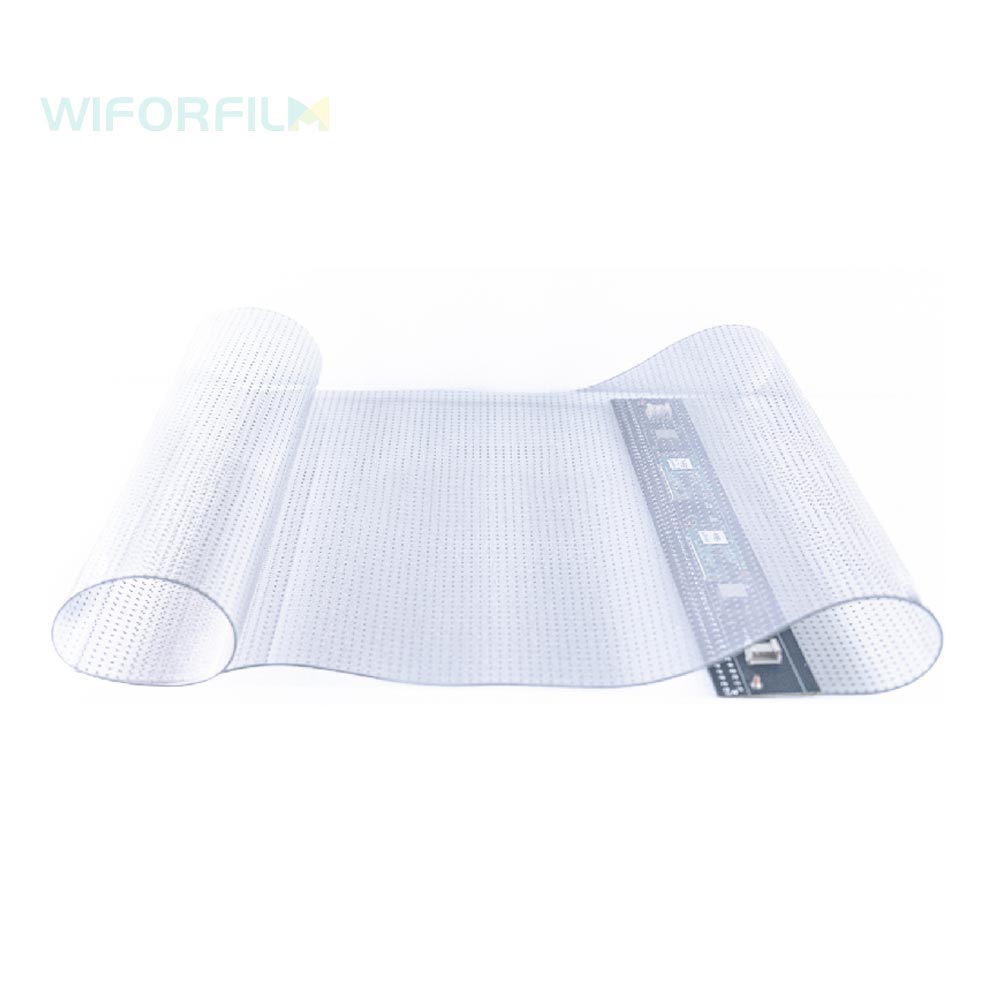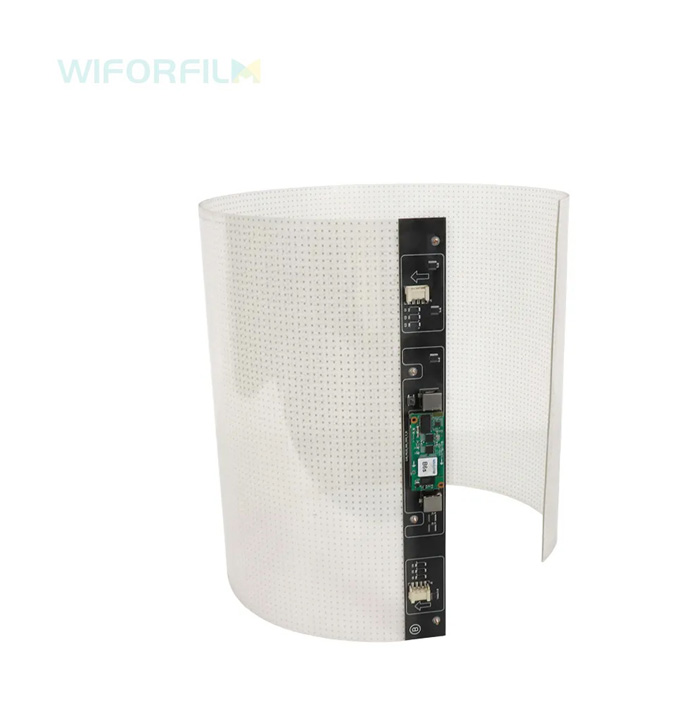- What is transparent LED film
- How Transparent LED Film Works
- Key Features of Transparent LED Film
- Benefits of Transparent LED Film
- Types of Transparent LED Film
- Material Composition of Transparent LED Film
- Transparent LED Film comparison with Traditional LED Displays
- Technical Specifications of Transparent LED Film
- Energy Efficiency of Transparent LED Film
- Applications of Transparent LED Film
- Installation of Transparent LED Film
- Maintenance of Transparent LED Film
- Transparent LED Film price
- How to Choose the Right Transparent LED Film
- Future Trends in Transparent LED Film Technology
What is transparent LED film
Transparent LED Film is an innovative display technology that integrates LED chips into a flexible PET transparent film with high light transmittance and excellent display quality. Transparent LED Film equipped with a self-adhesive backing, it can be directly applied to glass or Acrylic transparent panel smooth surfaces, enabling easy installation of display screens. Transparent LED Film widely used in building glass wall, storefront windows, exhibitions, and more without altering the original structure, it delivers dynamic content.How Transparent LED Film Works
Adhesive Transparent LED Film that integrates ultra-thin LED chips into a flexible, transparent PET substrate, which is then applied to glass,acrylic transparent panel or other transparent surfaces. Connect our dedicated APP through the Novastar controller to play images, videos, text management, and create vivid effects while maintaining the transparency of the substrate.Key Features of Transparent LED Film
- High Transparency: Allows up to 85%-95% visibility.
- Lightweight Design: Reduces load on structures.
- Flexible Installation: Easily adheres to curved or flat glass.
- Energy Efficiency: Low power consumption compared to traditional displays.
- Customizable Size and Shape: Tailored to project needs.
Benefits of Transparent LED Film
Invisible transparent led film characterized by its lightweight, transparent, and flexible features. Key benefits include:High Transparency: The transparent led film maintains the original clarity of glass without obstructing natural light or views.
Lightweight Design: Easy to install ,without requiring complex structural support.
Energy Efficiency: Low power consumption and long lifespan, reducing operational costs and supporting sustainability.
Versatile Application: The transparent led film customizable in size and shape, including curved surfaces, to meet diverse design needs.
Enhanced Visual Impact: Dynamic content delivery attracts attention and strengthens brand messaging.
Types of Transparent LED Film
There are several types based on different applications:Front-Projection Film: These films allow light to pass through while displaying images on the surface, suitable for retail displays and advertising.
Rear-Projection Film: Used for creating digital signage where the LED film is mounted behind a transparent surface, offering high-quality image visibility from the front.
Self-Adhesive Film: These films come with a sticky backing for easy installation on glass surfaces, offering flexibility and removability.
Flexible LED Film: Thin, bendable films that can conform to various surfaces, providing versatile display options.
Material Composition of Transparent LED Film
Transparent LED Film consists of:
- Flexible Polyethylene Terephthalate (PET) for durability.
- Embedded Micro-LEDs to generate visuals.
- Adhesive Layer for secure application on surfaces.
Transparent LED Film comparison with Traditional LED Displays
| Feature | Adhesive Transparent LED Film screen | Traditional Displays |
|---|---|---|
| Transparency | Up to 85%-95% | None |
| Weight | Lightweight | Heavy and bulky |
| Installation | Simple adhesive process | Complex mounting systems |
| Energy Efficiency | High | Moderate to high |
| Visual Appeal | Seamless integration | May appear obtrusive |
Technical Specifications of Transparent LED Film
| MODEL | P6.25 | P8 | P10 | P15 | P20 |
| Module size (mm) | 1000*400 | 1000*400 | 1000*400 | 1000*400 | 1000*400 |
| LED light | REE1515 | REE1515 | REE1515 | REE2121 | REE2121 |
| Pixel composition | R1G1B1 | R1G1B1 | R1G1B1 | R1G1B1 | R1G1B1 |
| Pixel spacing (mm) | 6.25*6.25 | 8*8 | 10*10 | 15*15 | 20*20 |
| Module pixel | 160*64=10240 | 125*50=6250 | 100*40=4000 | 66*26=1716 | 50*20=1000 |
| Pixel/m2 | 25600 | 16500 | 10000 | 4356 | 2500 |
| Brightness | 2000-3000 cd/m² | 2000-3000 cd/m² | 2000-4000 cd/m² | 2000-4000 cd/m² | 2000-4000 cd/m² |
| Permeability | 90% | 92% | 94% | 94% | 95% |
| Angle of view ° | 160 ° | 160 ° | 160 ° | 160 ° | 160 ° |
| Input voltage | AC110-240V50/ 60Hz | AC110-240V50/ 60Hz | AC110-240V50/ 60Hz | AC110-240V50/ 60Hz | AC110-240V50/ 60Hz |
| Peak power | 600w/㎡ | 600w/㎡ | 600w/㎡ | 600w/㎡ | 600w/㎡ |
| Average power | 200w/㎡ | 200w/㎡ | 200w/㎡ | 200w/㎡ | 200w/㎡ |
| Work environment |
Temperature -20~55°C Humidity 10-90% |
Temperature -20~55°C Humidity 10-90% |
Temperature -20~55°C Humidity 10-90% |
Temperature -20~55°C Humidity 10-90% |
Temperature -20~55°C Humidity 10-90% |
| Weight | 1.3kg | 1.3kg | 1.3kg | 1.3kg | 1.3kg |
| Thickness | 2.5mm | 2.5mm | 2.5mm | 2.5mm | 2.5mm |
| Drive mode | Static state | Static state | Static state | Static state | Static state |
| Control system | Nova/Colorlight | Nova/Colorlight | Nova/Colorlight | Nova/Colorlight | Nova/Colorlight |
| Typical value of life | 100000H | 100000H | 100000H | 100000H | 100000H |
| Grayscale level | 16bit | 16bit | 16bit | 16bit | 16bit |
| Refresh rate | 3840 Hz | 3840 Hz | 3840 Hz | 3840 Hz | 3840 Hz |
Energy Efficiency of Transparent LED Film
This transparent LED film is typically made of thin, flexible PET materials embedded with LEDs, which can be applied to windows or other transparent surfaces. Compared to traditional led screen, it consumes less power and provides energy-efficient , often using advanced technologies such as OLED or micro-LED.average power 200w/㎡Applications of Transparent LED Film
Advertising and Retail: The transparent led film used in storefront windows and glass walls, allowing dynamic digital displays without obstructing the view.Smart Glass: invisible transparent led film integrated into windows for smart buildings, providing privacy on demand by switching between transparent and opaque modes.
Interactive Displays: transparent led film for glass common in exhibitions, museums, and events, where users can interact with the content displayed on transparent surfaces.
Interior Design: Adhesive Transparent LED Film used to create ambient lighting, decorative effects, or innovative visual displays in commercial and residential settings.
Installation of Transparent LED Film
Surface Preparation: Clean and dry the glass or acrylic transparent panel.Measurement and Cutting: Tailor the transparent led film to the desired size.
Application: Peel the backing and apply to the glass or acrylic transparent panel.
Electrical Connection: Connect to the power source.
Testing and Calibration: Ensure proper display functionality.
Maintenance of Transparent LED Film
Transparent LED film requires regular maintenance to ensure optimal performance and longevity. Key maintenance practices include:
-
Cleaning: Use a soft, lint-free cloth to gently wipe the surface. Avoid abrasive cleaners or solvents that can damage the Transparent LED film. A mild, non-abrasive cleaner and water are recommended.
-
Inspection: Regularly check for signs of wear, such as flickering, dead pixels, or loose connections. Early detection can prevent more extensive damage.
-
Temperature Control: Ensure that the Transparent LED film is not exposed to extreme temperatures or humidity, which can affect its performance.
-
Power Supply Check: Verify that the power supply is stable and within the specified voltage range to prevent damage to the Transparent LED film.
-
Storage: If the Transparent LED film is not in use, store it in a dry, cool place to avoid environmental damage.
Transparent LED Film price
The price of transparent LED film varies depending on factors such as specifications, light transmittance, and resolution. Our transparent LED film price range from $600 to $2,300 per square meter. The exact price will depend on the project scale, customization requirements, and installation services. We recommend consulting with us for an accurate quote and technical support.How to Choose the Right Transparent LED Film
Choosing the right transparent LED film involves considering the following key factors:Transparency and Brightness: Select a transparent led film display screen with a high level of transparency and brightness, ensuring clear visibility and vibrant display when lit.
Size and Compatibility: Ensure the transparent led film display screen fits your intended installation area, whether it's windows, glass walls, or other transparent surfaces. It should be easy to cut and customize.
Resolution: Opt for a transparent LED film with a resolution suitable for your display needs. Higher resolution ensures sharper images and clearer text.
Durability: Look for transparent LED film with good durability and resistance to outdoor conditions (such as weather, UV exposure) if used in external environments.
Power Efficiency: Choose energy-efficient transparent LED film to reduce operating costs and minimize environmental impact.
Ease of Installation: Consider transparent led film display screen with simple adhesive backing or easy mounting options, which can save time and effort during setup.
Future Trends in Transparent LED Film Technology
Transparent LED film technology is rapidly evolving, with several key trends shaping its future.Enhanced Flexibility and Thinness: Future transparent LED film will become even thinner and more flexible, allowing for integration into a wider range of surfaces, including curved and irregular structures, without compromising performance.
Improved Transparency: As transparency improves, these transparent led film display screen will become less noticeable when turned off, making them more adaptable for applications like smart windows and displays integrated into architectural elements.
Higher Efficiency and Brightness: Advances in materials and design will lead to brighter screen with lower power consumption, making transparent LED film more energy-efficient and suitable for outdoor advertising and public spaces.
Cost Reduction: As production technologies scale and mature, costs are expected to decrease, making transparent LED films more accessible for a broader range of industries and consumer markets.










